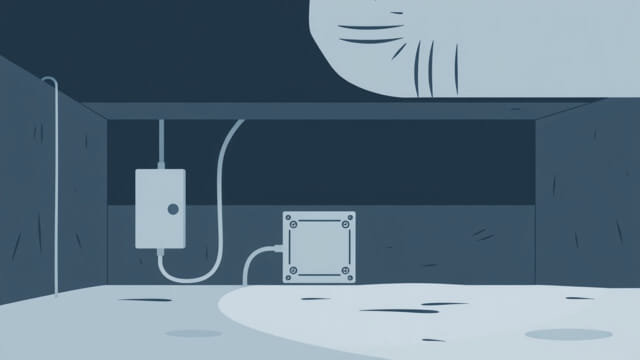When inspecting or upgrading home electrical systems, especially those in hard-to-reach areas, it is important to understand the role and safety requirements of junction boxes in crawlspaces. These boxes are used to protect wire connections and are essential for ensuring long-term safety and code compliance. However, many homeowners overlook the condition and placement of junction boxes beneath their homes, not realizing that poor installation or lack of accessibility can lead to hazards such as electrical fires or inspection failures. Understanding junction box safety in crawlspaces is critical for maintaining a secure and efficient home environment.
What Is a Junction Box?
A junction box is an enclosure used to house electrical connections, such as splices or terminals, between wires. Its main function is to prevent short circuits and protect the electrical connections from environmental damage or accidental contact. In crawlspaces, where moisture, rodents, and other environmental challenges exist, junction boxes must be properly secured and covered to avoid risks.
Types of Junction Boxes
- Plastic junction boxes Lightweight and resistant to corrosion but can be brittle over time.
- Metal junction boxes More durable and often required in commercial or high-risk environments.
Why Junction Box Safety in Crawlspaces Matters
Electrical work in crawlspaces is often hidden from view, making it more prone to neglect. Improperly secured or uncovered junction boxes can create major safety issues. Here’s why junction box safety is especially important in these confined areas:
- Fire Prevention: Exposed wires or loose connections can overheat and lead to electrical fires.
- Moisture Protection: Crawlspaces are prone to damp conditions. Without sealed junction boxes, water can enter the box and cause corrosion or shorts.
- Rodent Damage: Rodents can chew on wires and enter boxes that are not properly sealed.
- Code Compliance: Improper installations can lead to failure during home inspections or insurance reviews.
Electrical Code Requirements for Junction Boxes
Electrical codes such as those in the National Electrical Code (NEC) outline specific requirements for junction boxes, especially in crawlspaces. Some of the key rules include:
- Accessibility: Junction boxes must remain accessible for inspection and maintenance. They cannot be buried behind walls or under insulation without access panels.
- Cover Plates: All junction boxes must have a cover plate securely fastened to the box to prevent exposure of live wires.
- Box Fill: The number of conductors and devices inside a junction box must not exceed its rated capacity to avoid overheating.
- Secure Mounting: Boxes must be securely mounted to a structure such as a joist, and not left dangling by wires.
Common Mistakes Homeowners Make
There are several common errors that homeowners or inexperienced installers make when dealing with crawlspace junction boxes:
Leaving Boxes Uncovered
Sometimes people splice wires and leave them hanging without a box or cover. This is dangerous and violates electrical codes.
Installing in Inaccessible Locations
If you install a junction box behind an HVAC unit or deeply recessed without a clear path, it violates the accessibility rule and can cause major trouble during repairs or inspections.
Overstuffing Boxes
Putting too many wires inside a box causes heat buildup and increases the chance of a short circuit. Boxes should always be sized appropriately based on the number and size of wires.
Best Practices for Safe Installation
To ensure your junction box in a crawlspace is safe and up to code, follow these essential practices:
Use Moisture-Resistant Boxes
Since crawlspaces are naturally humid or even wet, consider using junction boxes rated for damp locations. Boxes made of corrosion-resistant materials can last longer and provide better protection.
Install GFCI Protection Where Needed
If your crawlspace includes receptacles or devices that could get wet, install a ground-fault circuit interrupter (GFCI) upstream. This adds a layer of safety by cutting power if water causes a short circuit.
Label Circuits Clearly
Labeling each wire or box with its circuit number or destination helps during future maintenance and avoids confusion.
Seal All Openings
Ensure all cable entry points are sealed with approved clamps or bushings to prevent pest entry and wire abrasion.
Use Proper Tools and Materials
Always use wire nuts or other approved connectors for splicing. Avoid twisting wires together without protection. Use mounting brackets or screws to fix the box in place securely.
When to Call a Licensed Electrician
Not all homeowners are comfortable working with electrical systems, especially in dark and cramped crawlspaces. In the following scenarios, it’s best to call a licensed electrician:
- You’re unsure about circuit capacity or code requirements.
- The crawlspace is damp, moldy, or structurally unsafe.
- You need to run multiple new circuits or upgrade existing wiring.
- There’s evidence of previous DIY wiring that looks questionable.
Professional electricians not only ensure that the work meets local codes, but they also have the tools and knowledge to complete the job safely in potentially hazardous conditions.
Routine Maintenance and Inspection
Even if a junction box in your crawlspace is installed properly, it should still be checked periodically. Here’s what to look for:
- Rust or Corrosion: Indicates moisture ingress. Replace or relocate the box if needed.
- Missing Covers: Replace immediately to prevent exposure.
- Rodent Activity: Check for chew marks on wires and take pest control measures.
- Loose Wiring: If wires are pulling out of connectors, re-secure them safely.
Junction box safety in crawlspaces is an essential yet often neglected aspect of home electrical maintenance. These small enclosures play a big role in ensuring that connections remain protected from moisture, pests, and physical damage. By using proper materials, following code, and conducting regular inspections, homeowners can avoid serious hazards and costly repairs. Whether you are planning new electrical installations or checking existing ones, always prioritize the safety and accessibility of your junction boxes. A properly installed and maintained junction box in the crawlspace contributes to the overall integrity of your home’s electrical system.
